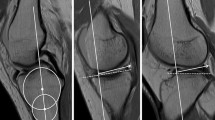Abstract
Objective
To clarify the advantage of prone position over supine position in radiographically-demonstrating anterior knee laxity measurement for anterior cruciate ligament (ACL) injury, and to optimize the radiographic technique for the ACL-deficient knees in a clinical setting.
Materials and methods
Thirty-nine patients with unilateral ACL injury had consented to participate in this study. They were divided into two groups and subjected to the different radiographic evaluations: study 1 (20 patients); supine versus prone position with knee full-extended, and study 2 (19 patients); comparison of (1) prone position with knee full-extended (FPV), (2) prone position with knee flexed at 15° (AGV), and (3) supine position with calf put on a board at 15° of knee flexion (SGV). Lateral radiographs for both knees were taken and were measured the side-to-side difference of tibial position related to femur.
Results
In study 1, the side-to-side difference was 2.8 ± 1.0 mm in supine position and 4.3 ± 2.1 mm in prone position, showing a statistically significant difference. In study 2, the side-to-side difference was 3.7 ± 2.4 mm in FPV, 4.6 ± 2.0 mm in AGV, and 4.2 ± 2.8 mm in SGV, while the difference in the latter two positions was larger than that in FPV.
Conclusions
The anterior laxity in prone position is larger than that in supine position for ACL injury. Moreover, the gravity-assisted lateral radiograph in prone position with knee flexed at 15° could be one of the preferable radiographic techniques and could provide more information than the simple radiograph.




Similar content being viewed by others
References
Daniel DM, Malcom LL, Losse G, Sachs R, Burks R. Instrumented measurement of anterior laxity of the knee. J Bone Joint Surg Am. 1985;67(5):720–6.
Shino K, Inoue M, Horibe S, Nakamura H, Ono K. Measurement of anterior instability of the knee. A new apparatus for clinical testing. J Bone Joint Surg Br. 1987;69(4):608–13.
Markolf KL, Graff-Radford A, Amstutz HC. In vivo knee stability. A quantitative assessment using an instrumented clinical testing apparatus. J Bone Joint Surg Am. 1978;60(5):664–74.
Uh BS, Beynnon BD, Churchill DL, Haugh LD, Risberg MA, Fleming BC. A new device to measure knee laxity during weightbearing and nonweightbearing conditions. J Orthop Res. 2001;19(6):1185–91. https://doi.org/10.1016/S0736-0266(01)00055-9.
Jacobsen K. Stress radiographical measurement of the anteroposterior, medial and lateral stability of the knee joint. Acta Orthop Scand. 1976;47(3):335–40.
Staubli HU, Noesberger B, Jakob RP. Stress radiography of the knee: cruciate ligament function studied in 138 patients. Acta Orthop Scand Suppl. 1992;249:1–27.
Kobayashi S, Terayama K. Quantitative stress radiography for diagnosis of anterior cruciate ligament deficiency. Comparison between manual and instrument techniques and between methods with knee flexed at 20 degrees and at 90 degrees. Arch Orthop Trauma Surg. 1993;112(3):109–12.
Balasch H, Schiller M, Friebel H, Hoffmann F. Evaluation of anterior knee joint instability with the Rolimeter. A test in comparison with manual assessment and measuring with the KT-1000 arthrometer. Knee Surg Sports Traumatol Arthrosc. 1999;7(4):204–8. https://doi.org/10.1007/s001670050149.
Ganko A, Engebretsen L, Ozer H. The rolimeter: a new arthrometer compared with the KT-1000. Knee Surg Sports Traumatol Arthrosc. 2000;8(1):36–9. https://doi.org/10.1007/s001670050008.
Panisset J-C, Ntagiopoulosb P-G, Sagginc PR, Dejour D. A comparison of telos stress radiography versus Rolimeter in the diagnosis of different patterns of anterior cruciate ligament tears. Orthop Traumatol Surg Res. 2012;98(7):751–8. https://doi.org/10.1016/j.otsr.2012.07.003.
Dejour H, Walch G, Chambat P, Ranger P. Active subluxation in extension: a new concept of study of the ACL deficient knee. Am J Knee Surg. 1998;1:204–11.
Fukuta H, Takahashi S, Hasegawa Y, Ida K, Iwata H. Passive terminal extension causes anterior tibial translation in some anterior cruciate ligament-deficient knees. J Orthop Sci. 2000;5(3):192–7. https://doi.org/10.1007/s007760000050192.776.
Nakamura K, Koga H, Sekiya I, Watanabe T, Mochizuki T, Horie M, et al. Evaluation of pivot shift phenomenon while awake and under anaesthesia by different manoeuvres using triaxial accelerometer. Knee Surg Sports Traumatol Arthrosc. 2017;25(8):2377–83.
Nagai K, Hoshino Y, Nishizawa Y, Araki D, Matsushita T, Matsumoto T, et al. Quantitative comparison of the pivot shift test results before and after anterior cruciate ligamentre construction by using the three-dimensional electromagnetic measurement system. Knee Surg Sports Traumatol Arthrosc. 2015;23(10):2876–81.
Shino K, Mitsuoka T, Horibe H, Hamada M, Nakata K, Nakamura N. The gravity sag view: a simple radiographic technique to show posterior laxity of the knee. Arthroscopy. 2000;16(6):670–2. https://doi.org/10.1053/jars.2000.7688.
Markolf KL, Gorek JF, Kabo M, Shapiro MS. Direct measurement of resultant forces in the anterior cruciate ligament. J Bone Joint Surg Am. 1990;72(4):557–67.
Almekinders LC, Chiavetta JB. Tibial subluxation in anterior cruciate ligament-deficient knee: implications for tibial tunnel placement. Arthroscopy. 2001;17(9):960–2.
Markolf KL, Kochan A, Amstutz HC. Measurement of knee stiffness and laxity in patients with documented absence of the anterior cruciate ligament. J Bone Joint Surg Am. 1984;66(2):242–53.
Highgenboten CL, Jackson AW, Jansson KA, Meske NB. KT-1000 arthrometer: conscious and unconscious test results using 15, 20, and 30 pounds of force. Am J Sports Med. 1992;20(4):450–4.
Author information
Authors and Affiliations
Corresponding author
Ethics declarations
Conflict of interest
The authors declare that they have no conflicts of interest.
Ethical approval
All procedures performed in studies involving human participants were in accordance with the ethical standards of the institutional and/or national research committee and with the 1964 Helsinki Declaration and its later amendments or comparable ethical standards.
Informed consent
Informed consent was obtained from all individual participants included in the study.
Rights and permissions
About this article
Cite this article
Mae, T., Shino, K., Hiramatsu, K. et al. Anterior laxity of the knee assessed with gravity stress radiograph. Skeletal Radiol 47, 1349–1355 (2018). https://doi.org/10.1007/s00256-018-2941-5
Received:
Revised:
Accepted:
Published:
Issue Date:
DOI: https://doi.org/10.1007/s00256-018-2941-5




